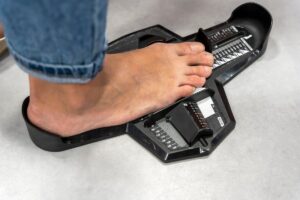Many individuals encounter daily challenges related to having wide feet, but finding the right footwear can be an effortless endeavor. Issues such as discomfort, blisters, and a limited variety of shoes are common. However, understanding your feet’s unique requirements can significantly enhance your experience. Wearing improperly fitting shoes can lead to severe foot complications, including bunions and chronic pain. Acknowledging that wide feet are a normal variation is the first step toward achieving comfort, and selecting appropriate shoes can help prevent long-term foot health issues. This comprehensive guide aims to deepen your understanding of wide feet and assist you in selecting shoes that seamlessly combine comfort with style.
Understand the Unique Characteristics of Wide Feet for Better Shoe Choices
Gaining a comprehensive understanding of your wide feet is crucial for making knowledgeable footwear choices. Research shows that about 30% of adults have feet that are wider than standard shoe sizes. Various factors such as genetics, age, and lifestyle choices can influence foot width. By recognizing these influences, you can select shoes that cater specifically to your unique foot shape and ensure a better fit, enhancing both comfort and mobility.
Embrace the Natural Variability in Your Foot Structure
Just as height and body shape differ from person to person, foot width varies naturally as well. Your genetic background plays a significant role in determining your foot structure. If wide feet run in your family, it’s important to recognize that this trait is common rather than a medical concern. Understanding the genetic factors that contribute to your foot shape can empower you to embrace your unique characteristics and make better footwear selections tailored to your needs.
Be Aware of How Life Changes Affect Foot Width
Throughout your life, various changes can lead to wider feet. Pregnancy can cause an increase in foot width by up to one full size, and as you age or experience weight fluctuations, you might notice changes in your foot size. Additionally, prolonged periods of standing or certain medical conditions may contribute to foot width changes. Being aware of these developments allows you to adjust your footwear choices appropriately. Regularly measuring your feet is advisable, as they can change size every few years due to factors like weight changes, aging, and physical activity. Neglecting to adjust your shoe choices can lead to foot issues, such as bunions, corns, and ongoing discomfort.
Investigate the Common Causes Leading to Wide Feet
Understanding the underlying reasons for your wider-than-average feet is essential. Multiple factors can contribute to wide feet, including genetics, medical conditions, and lifestyle choices. By recognizing these factors, you can identify potential solutions that are tailored to your individual needs and help improve your overall comfort.
Examine the Genetic Factors Influencing Foot Width
Your family history and inherited foot structure significantly influence the width of your feet from birth. Traits such as bone structure and arch type are passed down through generations, affecting how your feet develop. By understanding these inherited characteristics, you can gain valuable insights into the distinctive shape of your feet and make informed choices regarding footwear that accommodates your specific needs.
Identify Medical Conditions That May Affect Foot Width
In some cases, underlying health conditions may contribute to the widening of your feet. Common issues such as diabetes, arthritis, and edema can alter the shape and size of your feet.
The effects of medical conditions on foot width can be temporary or permanent. For example, your feet may swell during pregnancy, following an injury, or due to circulation problems. Regular check-ups with your healthcare provider can help you monitor any changes and address potential issues proactively, ensuring that your footwear continues to fit comfortably.
Assess Lifestyle Factors That Influence Foot Width
Experts affirm that your daily habits significantly impact your foot width. Prolonged standing, excessive weight, and unsuitable footwear can lead to a gradual widening of your feet over time.
Your lifestyle, combined with genetic and environmental factors, plays a crucial role in determining your foot width. High-impact activities and poor shoe choices can expedite this change. The nature of your job and everyday habits significantly influences your foot health and overall comfort.

Understand the Health Implications Associated with Wide Feet
Compared to individuals with standard foot widths, those with wide feet may face serious health complications if their footwear does not provide adequate support. Your foot width can impact your entire body’s alignment and influence your joints, posture, and overall mobility. Research indicates that an alarming 72% of individuals wear shoes that are the incorrect width, which can lead to preventable foot ailments and discomfort.
Recognize the Physical Effects of Having Wide Feet
Studies show that around 65% of individuals with untreated wide feet suffer from chronic foot pain. When your foot support is inadequate, your body compensates by altering your walking pattern, leading to knee pain, hip discomfort, and lower back issues. Over time, these compensatory adjustments can result in lasting joint problems if you don’t wear shoes that fit properly.
Address Daily Comfort Challenges for Your Feet
When your footwear doesn’t accommodate your wide feet, everyday activities can become challenging. You may experience immediate discomfort, blisters, and pressure points that hinder your mobility. Research shows that 80% of individuals with wide feet report reduced activity levels due to foot discomfort.
The repercussions of wearing ill-fitting shoes extend beyond temporary discomfort. Your feet may develop painful conditions such as bunions, corns, and calluses, adversely affecting your balance and stability. This situation makes you more susceptible to falls and injuries. Therefore, choosing the right footwear is essential for maintaining foot health and overall well-being.
Find Effective Footwear Solutions Specifically for Wide Feet
Locating suitable footwear is vital for individuals with wide feet, ensuring both comfort and the promotion of foot health. Your shoes should provide sufficient space while delivering the necessary support and stability for your daily activities.
Understand the Importance of Proper Measurement for Shoe Fitting
Accurate foot measurements are fundamental to selecting shoes that fit correctly. Measure your feet at the end of the day when they are at their largest, and remember to measure both feet, as sizes may vary between them.
Discover the Ideal Shoe Types for Wide Feet
Certain shoe styles are more effective than others when it comes to accommodating wide feet.
| Feature | Benefit |
|---|---|
| Wide toe box | Allows natural toe spread |
| Adjustable closures | Customizable fit |
| Breathable materials | Reduces swelling |
| Deep heel cup | Provides stability |
| Flexible sole | Adapts to foot shape |
- Athletic shoes featuring mesh uppers
- Sandals equipped with adjustable straps
- Loafers available in wide widths
- Boots designed with stretch panels
For instance, specific shoe designs can significantly enhance your comfort levels.
| Shoe Type | Best Features |
|---|---|
| Running shoes | Extra width options |
| Walking shoes | Roomy toe area |
| Casual shoes | Stretchable materials |
| Dress shoes | Multiple width options |
| Work boots | Wide-fit designs |
Follow Essential Shopping Guidelines for Finding Wide Feet Footwear
Your success in finding comfortable shoes for wide feet depends on careful planning and informed decisions. Seek out specialty stores that provide wide-width options and have knowledgeable staff to assist with accurate measurements. It’s best to shop in the afternoon when your feet are naturally at their widest to ensure an optimal fit.
Select the Right Brands Known for Wide Feet Footwear
To discover suitable footwear, focus on brands recognized for their wide-width offerings, such as New Balance, Brooks, and ASICS. These brands design shoes with added room in the toe box and midfoot area, enhancing comfort for individuals with wide feet. Prioritizing quality construction and proper support is essential for your long-term satisfaction and comfort.

Gain Expert Fitting Tips for Optimal Comfort
Successful shoe purchases rely heavily on effective fitting techniques. Follow these essential guidelines:
- Measure both feet while standing
- Ensure thumb-width space at the toe area
- Try shoes on with your regular socks
- Test the shoes by walking around in them
- Shop during the late afternoon
Experiencing immediate comfort is crucial for making the right decision.
Fitting procedures require careful attention and patience. Consider these additional factors:
- Check for proper arch support
- Ensure no pressure points exist
- Verify heel stability
- Test flexibility at the ball of the foot
- Explore various lacing techniques
Paying attention to these details will help you find the perfect fit for your wide feet.
Implement Effective Maintenance and Care for Your Footwear
Proper care for your wide feet involves regular attention to maintain foot health and extend the lifespan of your shoes. Incorporate adequate cleaning and drying of both shoes and feet into your daily routine to prevent issues such as fungal infections and unpleasant odors. Consistent upkeep can reduce foot pain by up to 40% and prolong the life of your footwear.
Adopt Daily Practices to Enhance Your Foot Health
Beneficial practices for your wide feet include rotating between different pairs of shoes to allow for adequate drying time and minimize excessive wear. After each use, wipe your shoes clean and consider using shoe trees to maintain their shape. These simple yet effective steps can increase the lifespan of your shoes by up to 2 years while also providing better support for your feet.
Establish Long-Term Prevention Strategies for Foot Health
Consistent care for your wide feet requires ongoing attention to prevent future complications. You should replace your shoes every 400-500 miles of walking or when you notice significant wear patterns. Regular foot measurements are also necessary, as your foot width can change over time.
While caring for your footwear, prioritize foot exercises and stretches. Engaging in regular foot exercises can enhance flexibility by 30% and alleviate discomfort. Ensure your feet receive adequate circulation by avoiding prolonged sitting, and consider using compression socks if you need to stand for extended periods.
Reflecting on your journey to find the perfect footwear for wide feet can be straightforward with the right knowledge. By understanding your foot width, selecting brands that cater to wide sizes, and implementing effective measurement techniques, you can make better shoe choices. Your comfort is paramount, so take the time to try on various shoes and ensure they provide ample space for your feet. Adopting these tips and remaining mindful of how your shoes fit will lead you to footwear that supports your daily activities while keeping your feet healthy and free from pain.
Find Answers to Common Questions About Wide Feet
What’s the best method to measure my feet for suitable wide-width shoes?
Stand on a piece of paper while wearing your regular socks. Trace both feet and measure their length and width at the widest points. Performing this task in the evening is ideal, as your feet are at their largest then. Compare your measurements to standard shoe size charts and choose shoes that correspond to the size of your larger foot. Always test new shoes by walking around in them for several minutes to evaluate comfort.
Which shoe features should individuals with wide feet prioritize for better fit?
Look for shoes that have a wide toe box, allowing your toes to spread naturally. Seek shoes labeled with “W” for wide or “EE” width. Opt for materials such as soft leather or mesh that can stretch and adapt to the shape of your feet. Choose shoes with adjustable features, like laces or straps, and avoid pointed toe designs in favor of rounded or square toe shapes for optimal comfort.
How can I prevent foot problems caused by incorrect shoe sizes?
Replace any shoes that show signs of significant wear. Purchase shoes from brands that specialize in wide-width options. Ensure your toes have adequate space to move comfortably. If necessary, consider using shoe inserts for additional support, and alternate between different pairs of shoes daily to reduce wear. It’s a good idea to check your foot size annually, as feet can change over time, and discontinue wearing shoes that cause pain or discomfort.
The Article The Ultimate Wide Feet Guide: Concerns, Footwear Tips, and More appeared first on My Shoes Finder
The Article Wide Feet Guide: Essential Tips and Footwear Solutions Was Found On https://limitsofstrategy.com



You’ve touched on a crucial yet often overlooked aspect of footwear—the significance of understanding our unique foot shapes, particularly for those with wide feet. It’s fascinating to consider how societal norms regarding beauty and style often overshadow these practical concerns. When shopping for shoes, many of us focus on aesthetics, forgetting the importance of fit and comfort. This can lead to a cycle of frustration and ultimately health issues.
You’ve brought up an important point. It’s easy to get swept up in trends and forget that comfort should take the lead in our footwear choices. Wide feet, in particular, can make shopping feel like a minefield. So many designs prioritize a specific aesthetic over what provides real comfort, and that can lead to a frustrating experience and some lasting issues down the road.
You’ve raised a really important point about footwear that doesn’t get enough attention. Our feet aren’t one-size-fits-all, and when we prioritize looking good over comfort, it can really take a toll over time.
You’ve hit on a crucial issue, and it’s refreshing to see this perspective gaining more traction. Footwear plays such a significant role in our overall well-being, yet many still overlook how critical it is to find the right fit. Comfort often takes a backseat to style, but our feet are not just about aesthetics; they’re foundational to our health.
I really appreciate this deep dive into the challenges of finding the right footwear for those of us with wide feet. It resonates with me personally since I’ve struggled for years with discomfort and blisters due to poorly fitting shoes. There seems to be a real gap in the mainstream shoe market when it comes to accommodating wider widths, which is frustrating, especially since shoes are such a fundamental part of our daily lives.